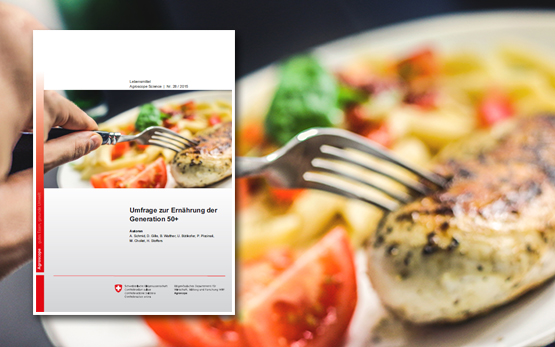Berger T., Mühlemann M., Ackermann-Gäumann R., Moor D., Ingenhoff J.-E.
Risk assessment of alimentary transmission of tick-borne encephalitis viruses from goats to humans by means of milk and milk products in Swiss alpine regions.
In: Swiss Society for Microbiology SSM. 31. August, Hrsg. CHUV - SSM, Lausanne. 2023.
Berger T., Mühlemann M.
Évaluation du risque de transmission par voie alimentaire du virus de l'encéphalite à tique de la chèvre à l'homme par le lait et les produits laitiers dans les régions alpines suisses.
In: Symposium AESA "Tiques et maladies à tiques : Quelles tendances ? Quels risques ?". 29 juin, Liège. 2023, 22-24.
Ingenhoff J.-E., Mühlemann M., Berger T.
FSME-Infektion nach Konsum von Schaf- und Ziegenrohmilchprodukten: eine Risikobewertung.
In: Cheese & Science. 1. Juni, Hrsg. Agroscope, Liebefeld. 2023.
weitere Sprachen: französisch
Ingenhoff J.-E., Berger T., Mühlemann M., Fehér N.
Phtalates dans l'industrie laitière : Éviter les plastifiants problématiques dans le lait et les produits laitiers.
In: Journée des conseillers en fromagerie romands et tessinois. 27 août, Cresciano. 2021, 1-17.
Mühlemann M.
Praxishilfe für die Bewertung von Indikatoren in den Risikokategorien des PrioTools.
Hrsg. Arbeitsgruppe PrioTool, V-00, 19. Mai, 2021, 23 S.
weitere Sprachen: französisch | italienisch
Mühlemann M., Imhof R., Lehmann I., Zaffarano P.
Handbuch PrioTool.
Hrsg. Arbeitsgruppe PrioTool, V-00, 19. Mai, 2021, 21 S.
weitere Sprachen: französisch | italienisch
Ingenhoff J.-E., Mühlemann M., Ackermann-Gäumann R., Moor D., Berger T.
Risk assessment of alimentary transmission of tick-borne encephalitis viruses from goats to humans by means of milk and milk products in alpine regions of Switzerland.
In: IDF International Cheese Science and Technology Symposium, June 7, 9 and 11, 2021. 07.06., Hrsg. IDF, IDF, virtual (Quebec). 2021.
Ingenhoff J.-E., Berger T., Mühlemann M.
Phthalate in der Milchwirtschaft: Problematische Weichmacher in Milch und Milchprodukten vermeiden.
Hrsg. Agroscope, Bern. Merkblatt Nr. 115, 2020, 4 S.
weitere Sprachen: französisch
Ingenhoff J.-E., Mühlemann M., Ackermann-Gäumann R., Moor D., Berger T.
Risk assessment of the alimentary transmission of tick-borne encephalitis viruses from goats to humans by milk and milk products in Swiss alpine regions.
Archiv für Lebensmittelhygiene, 71, (5), 2020, 110-114.
Mühlemann M.
Beurteilung Biozidprodukt CHZN4408 Autan Tropical Spray: Beurteilung z.H. BAG.
16.10., 2018
Mühlemann M.
Sécurité microbiologique et chimique des aliments.
Recherche Agronomique Suisse, 6, (5), 2015, 228-230.
Mühlemann M., Gille D., Kast C., Dübecke A.
Keine Pyrrolizidin Alkaloide in Schweizer Milch.
Alimenta, 01, 2015, 24.
Mühlemann M.
Microbiological and chemical risk assessment and its respective exposure modelling.
Agroscope Science, 8, 2014, 1-12.
Mühlemann M.
Development of a framework for the evaluation and prioritization of food and feed safety hazards and related research needs.
In: Kolloquium. 30.01., Hrsg. Agroscope, Bern. 2014, 1-25.
Mühlemann M.
Practitioner framework for the evaluation and prioritization of food and feed safety hazards and related research needs.
ALP science, (545), 2013, 1-12.
Mühlemann M.
Development of a framework for the evaluation and prioritization of food and feed safety hazards and related research needs.
In: Eurofoodchem XVII. 7.-10.05., Hrsg. SAFE Consortium Special Session on FOOD SAFETY, Istanbul. 2013, 1-18.
Walther B., Mühlemann M., Arias-Roth E., Wechsler D., Zehntner U., Guggenbühl B.
Cheese: Health Aspects and Microbiological Risks.
In: Cheese Ripening: Quality, Safety and Health Aspects. Chapter 11, Hrsg. ALP, Nova Science "Advances in Food Safety and Food Microbiology". 2013, 195-214.
Walther B., Mühlemann M.
Cheeses.
In: Encyclopedia of Lifestyle Medicine and Health. 2010, Hrsg. E. James M. Rippe, SAGE, Thousand Oaks, CA. 2012, 545-552.
Kast C., Mühlemann M., Dübecke, A., Beckh, G., Lüllmann, C.
Pyrrolizidin-Alkaloide in der Natur und ihre Bedeutung für Lebensmittel.
Schweizerische Bienen-Zeitung, (10), 2010, 14-16.
weitere Sprachen: französisch | italienisch
Berger T., Imhof R., Mühlemann M.
Drehscheibe für Neues und Wichtiges = Une plaque tournante pour les nouveautés.
Alimenta, (11), 2010, 33-34.






